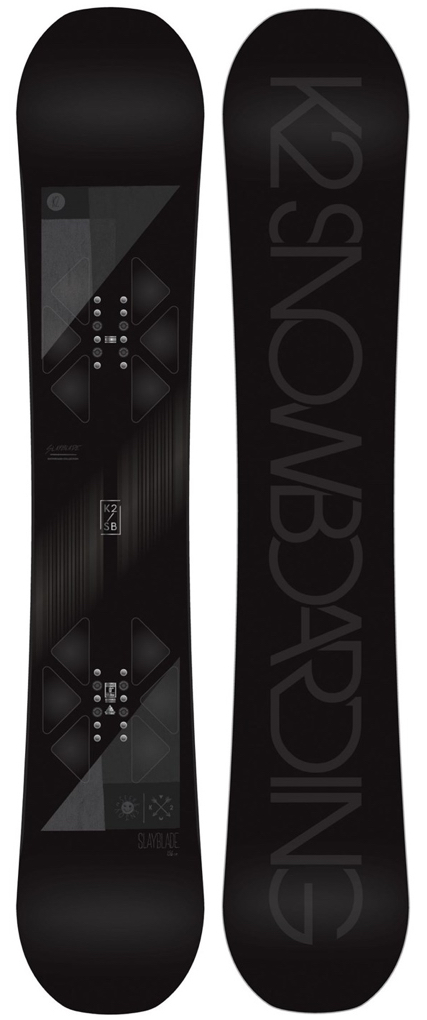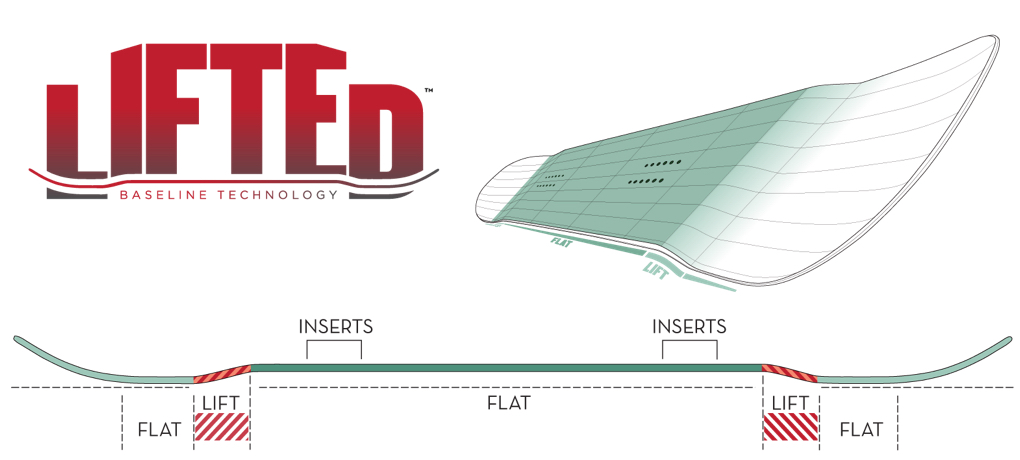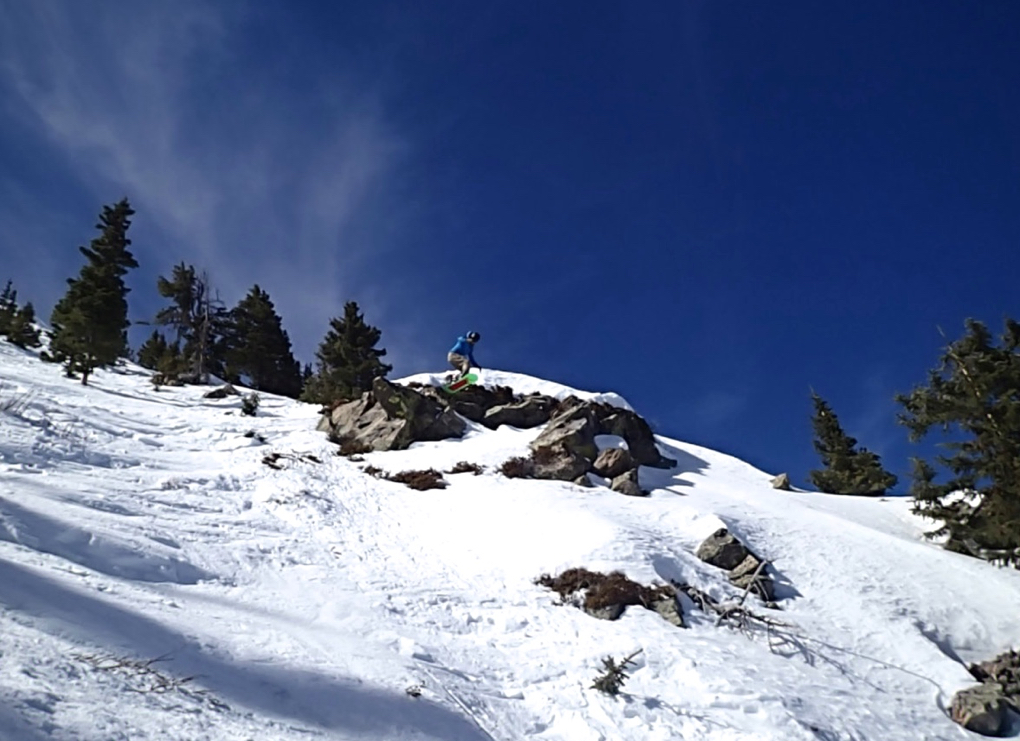
2014-2015 K2 Slayblade, 158cm and 161cm
Dimensions and Specs:
158cm:
- Nose / Tail Width: 29.9 mm
- Waist Width: 25.2 mm
- Sidecut Radius: 8.0 m
- Effective Edge: 124.4 cm
- Reference Stance: 56 cm (22 in)
- Weight Range: 59-95 kg (130 -210 lbs)
161cm:
- Nose / Tail Width: 30.2 mm
- Waist Width: 25.4 mm
- Sidecut Radius: 8.1 m
- Effective Edge: 31.1 cm
- Reference Stance: 56 cm (22 in)
- Weight Range: >68 kg (>150 lbs)
Features:
- Precision Lifted Flat Design
- Tweekends
- Harshmellow
- Hybritech
- Hyper Progressive Directional Twin
- Bambooyah, Blended WH4
- ICG “Integrated Carbon Glass” 20 / Biax
- Carbon Web II
- Ollie Bar
MSRP: $560
Reviewer: 5’10”, 170 lbs.
Stance: 23.5” wide; 15° front, -12° rear
Boots / Bindings: K2 Thraxis / Salomon Cypher (size M); Flow Rift Quickfit Boots / K2 Cinch Bindings (size M)
Test Locations: Taos Ski Valley, Canterbury Club Fields, New Zealand; Telluride and Crested Butte, Colorado
Days Tested: 60+
[Editor’s Note: Our review was conducted on the 13/14 Slayblade, which is unchanged for 14/15, except for the graphics.]
The K2 Slayblade has been one of my favorite all-mountain boards for a long time, and I’ve had the chance to ride several of the Slayblade models over the years.
Previously, the Slayblade was flat underfoot, and provided an excellent balance of stability and playfulness; I could charge hard on it, but still found the board to be really fun and poppy.
The Slayblade was updated during the 13/14 season, and several of those changes include a less rounded nose and tail, heavier weight, and a lifted, rather than flat, baseline. Despite some of these major updates to the board’s design, the Slayblade is still meant to be a stiff, strong, and fun all-mountain board.
And given how much I loved the flat version of the Slayblade, I was really curious as to how the lifted Slayblade would compare.
Flex / Design
The Slayblade is the stiffest board in K2’s lineup, and I have found it to be impressively stiff. While many boards end up being softer than companies claim them to be, I haven’t found this to be the case with the Slayblade. Since I tend to prefer stiffer boards for the added stability at high speed, I was pleased to see how stiff the new Slayblade flexed.
The updated Slayblade is also heavier, since the board uses a new construction, Hybritech, instead of the previous Hybrilite. The new Hybritech construction is supposed to beef up the board and make it a bit stiffer than before, while also incorporating a true sidewall along most of the edge along the board’s camber.
Another big change to the new Slayblade is the board’s Lifted Baseline technology. The board is basically flat toward the tip and tail, but has lifted inserts on either side so the board is raised up underfoot, simulating camber.
The idea behind this lifted design is that it attempts to maintain the benefits of having a flat board underfoot, while also providing some of the perks of a cambered board.

I absolutely loved the feel of the flat Slayblade when I first rode it several years ago, so I was a little skeptical as to how much better the Lifted Slayblade would ride. The flat Slayblade always maintained good contact with the snow along all points of the sidewall, and felt very poppy and playful.
In theory, the newer, cambered version should be more poppy and have better edge hold through carves, though it would also require the rider to be more assertive to prevent the edges from getting caught up.
The Slayblade is made with a blended bamboo wood core with some carbon in the nose and tail for added stiffness. There is also a convex carbon ollie bar between the feet to add a little extra pop.
Groomers / Hardpack
So how does this new design translate on snow? I found the Slayblade to be fast, strong, and powerful. The board’s stiffness certainly contributes to stability at high speeds down groomers and over firmer hardpack.
Compared to the original, flat Slayblade, the lifted camber Slayblade provides just as good edge hold in these conditions, but only once the board is locked into a turn. Both the nose and tail have this small area where the lifted profile drops down in relation to the flat portions of the board toward the nose and tail.
When not paying attention, I have had a couple of instances where the board gets caught in the snow, sending me down—usually resulting in a $0.50 cent fine per Taos Ski Patrol by-laws sect. 6.7.8.
While I’ve found this to be a little bit of an issue at slower speeds and when riding more casually, the lifted flat camber profile carves really well, and provides great edge hold on groomers once I put my weight into the board and am flexing it through the turn.

Another thing I noticed about the lifted base was the board’s decreased ability to smoothly scrub speed down the fall line. While this wasn’t super surprising, since it makes sense that a flat board would do this more predictably than a cambered board, it took a little while to get used to.
When riding around the Canterbury Club Fields in New Zealand, there were a lot of long traverses to get to some of the more techy terrain. The snow along the traverses was pretty inconsistent, with windblown powder, ice, chalk, and sun crust. While I loved the challenge of negotiating the traverses through the inconsistent snow, it required a lot of concentration. I noticed that if my nose ever caught some of the softer snow, the lifted inserts on the board would grab and catch in the snow. Occasionally, I felt like I was going to be thrown down, and I just learned that I had to be focused and on my A-game at all times.
While there have been some sacrifices in the Slayblade’s performance on hardpack with the updated design (the catchiness at slower speeds and while scrubbing speed), the board has maintained great edge hold on firmer snow and feels more stable. Once the board is up to speed, I can negotiate lines with more speed and confidence than I could on the flat Slayblade.
Powder
The Slayblade has been a good board in powder, although I’ve ridden few boards that aren’t super fun in deep, fresh snow.
I’ve ridden a number of boards in powder that provide a feeling that could be described as “corky,” which would be like a wine cork bobbing up and down in wine. This is maybe one of the best feelings in the world, and is really playful. The flat Slayblade used to do this well, though the newer one does not feel quite as corky. Rather, the lifted Slayblade provides more of a “plowy” sensation, and effectively pushes snow out of the way instead of floating through it. It required a little extra strength and effort to pop the board out of the powder, too. Still, despite this change in powder performance, I’ve found the Slayblade to be a fun board in powder.
NEXT: Crud, Jumping, and Sizing…

HI THERE I RIDE A K2 LIFELIKE SNOWBOARD 2011 – 2012 I WANT TO BUY A NEW BOARD WHAT BOARD COMPARES TO THE K2 LIFELIKE BECAUSE I LOVE RIDING THAT SNOWBOARD